Fujinon is a brand of optical lenses made by Fuji Photo Film Co., Ltd, now known as Fujifilm. Fujifilm's Fujinon lenses have been used by professional photographers and broadcast stations as well as cinematography. Fujifilm started manufacture of optical glass in its Odawara Factory in Japan in 1940, which was the start of the Fujinon brand. They were proud of their use of expensive Platinum crucibles to get the purest glass achievable at the time. Fujifilm also pioneered Electron Beam Coating (EBC) which according to Fujifilm, represented a new high in lens precision and performance. The EBC process was significantly different from other coating processes by the number of coating, the thinness of the coating, and the materials used for coating. Fujifilm claimed they were able to have as much as 14 layers of coating and used materials such as zirconium oxide, and cerium fluoride, which could not be used for coating in the conventional coating process. The first lens to offer the Electron Beam Coating was the EBC Fujinon 55mm F3.5 Macro in 1972. Light transmission for the coating was said to be 99.8%. EBC later evolved into Super-EBC and HT-EBC.

In signal processing, apodization is the modification of the shape of a mathematical function. The function may represent an electrical signal, an optical transmission, or a mechanical structure. In optics, it is primarily used to remove Airy disks caused by diffraction around an intensity peak, improving the focus.

Originally produced by Minolta, and currently produced by Sony, the STF 135mm f/2.8 [T4.5] is a photographic lens compatible with cameras using the Minolta AF and Sony α A-mount. STF stands for Smooth Trans Focus, in reference to its special optical system, which is intended to smooth the transition between the plane of focus and out-of-focus areas in the image. This is accomplished by the use of an apodization filter that provides the high-quality bokeh effect. The lens is not a soft-focus lens.

The Fujifilm X-Pro1 is a mirrorless interchangeable-lens digital camera announced in January 2012 and launched in March 2012. It is part of Fujifilm's X-Series of cameras. In October 2012 Fujifilm released a very similar, yet smaller, camera named the X-E1. In January 2016 Fujifilm announced its successor, the X-Pro2.

The Fujifilm X-mount is a lens mount for Fujifilm interchangeable lens mirrorless cameras in its X-series, designed for 23.6mm x 15.6mm APS-C sensors.
The Smooth Trans Focus (STF) technology in photographic lenses uses an apodization filter to realize notably smooth bokeh with rounded out-of-focus highlights in both the foreground and background. This is accomplished by utilizing a concave neutral-gray tinted lens element next to the aperture blades as apodization filter, a technology originally invented by Minolta in the 1980s, and first implemented in a commercially available lens in 1999. In contrast to soft focus lenses, STF lenses render a perfectly sharp image in the focus plane.
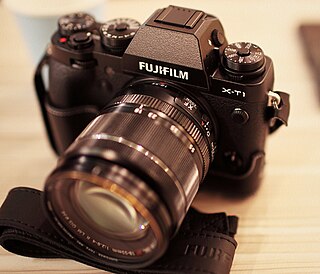
The Fujifilm X-T1 is a weather-resistant mirrorless interchangeable lens camera announced by Fujifilm on January 28, 2014. It uses the Fujifilm X-mount and is the first entry in the X-T lineage of DSLR-styled X series cameras.
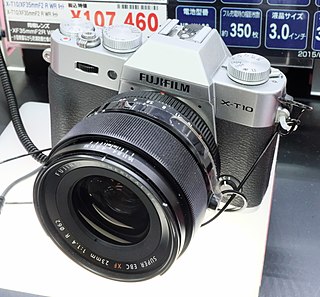
The Fujifilm X-T10 is a digital interchangeable-lens camera announced by Fujifilm on May 18, 2015. It is a smaller, lighter and lower priced alternative to the Fujifilm X-T1, Fujifilm's flagship camera. The camera was made available in an all black colour scheme, in addition to a silver and black colour scheme.
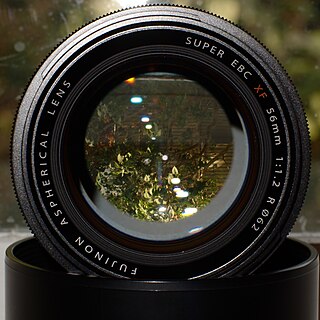
The Fujinon XF 56mm F1.2 R is an interchangeable camera lens announced by Fujifilm on January 6, 2014. As of 2015, it is one of the widest-aperture native mirrorless lenses.

The Fujifilm XF 35mm F1.4 R is an interchangeable camera lens announced by Fujifilm on January 9, 2012. As of 2015, it remains one of the widest-aperture 35mm lenses available, giving a normal field of view on Fujifilm's APS-C format digital cameras.

The Fujinon XF 60mm F2.4 R Macro is an interchangeable camera lens announced by Fujifilm on January 9, 2012. It is not a true macro lens, with magnification up to 1:2 rather than 1:1. As of July 2015, it is the only lens marketed for close-up work among Fujifilm's X mount offerings. However, Zeiss offers the Touit Makro-Planar T* 50mm f/2.8, which offers 1:1 magnification.
The Fujinon XF 27mm F2.8 is an interchangeable camera pancake lens announced by Fujifilm on June 25, 2013. At 27 mm, it has a 35 mm equivalent focal length of 41 mm, making it a normal lens of maximum aperture f/2.8. The intended benefit of this lens is its extreme compact size, extending only 23 mm (0.91 in) from the flange, and light weight, only 77.3 g (2.73 oz), with the trade off of having no aperture ring.
The Fujinon XF 23mm F1.4 R is an interchangeable camera lens announced by Fujifilm on September 5, 2013.
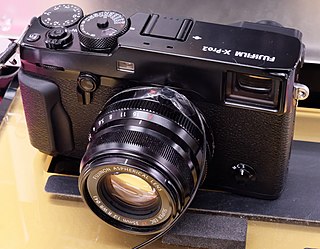
The Fujinon XF 35mm F2 R WR is an interchangeable standard prime lens for X-mount, announced by Fujifilm on October 21, 2015.
The Fujinon XF 90mm F2 R LM WR is an interchangeable camera lens announced by Fujifilm on May 18, 2015.

The Fujifilm X-Pro2 is a mirrorless interchangeable-lens digital camera announced in January 2016. It is part of Fujifilm's X-Series of cameras, the successor to the X-Pro1. Sales began on 3 March 2016.

The Fujifilm G-mount is a type of interchangeable lens mount designed by Fujifilm for use in the cameras of their Fujifilm GFX series. These cameras have interchangeable lenses. The respective lenses are designed for 43.8 mm x 32.9 mm medium format sensors.

The Fujifilm X-A3 is a rangefinder-styled digital mirrorless camera announced by Fujifilm on August 25, 2016. Sales began on November 10, 2016.
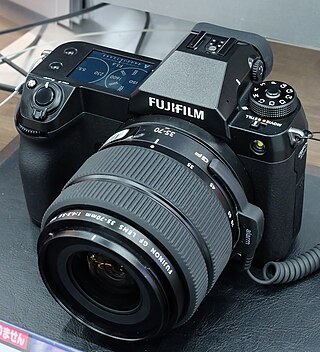
The Fujifilm GFX 50S II is a mirrorless medium format camera produced by Fujifilm. It features the Fujifilm G-mount. The camera, together with the X-T30 II, and some lenses, were announced by Fujifilm during the X Summit in Japan on September 2, 2021. The camera will be available for sale at the end of September 2021.













